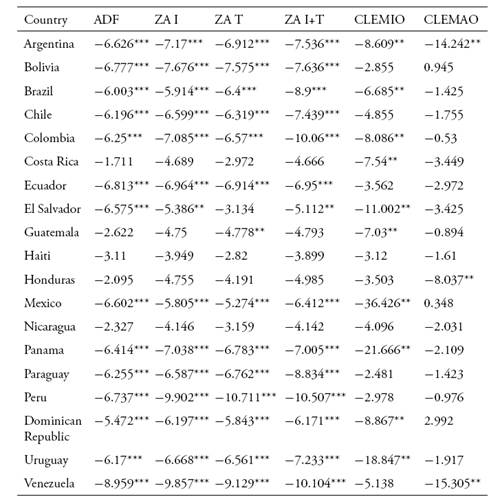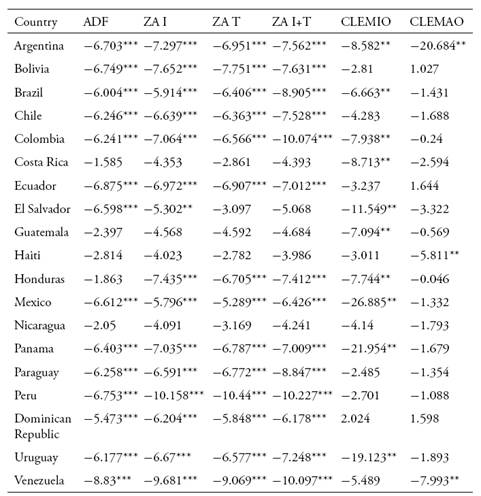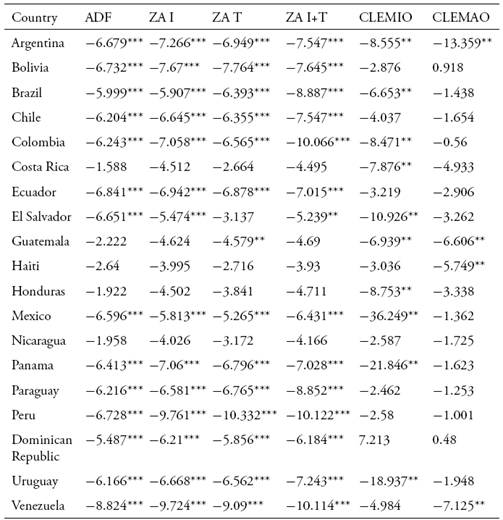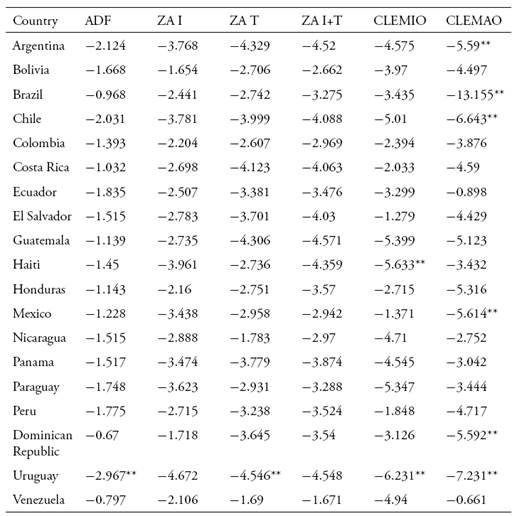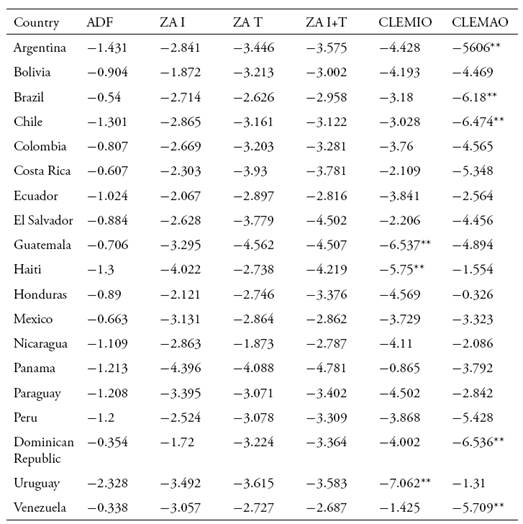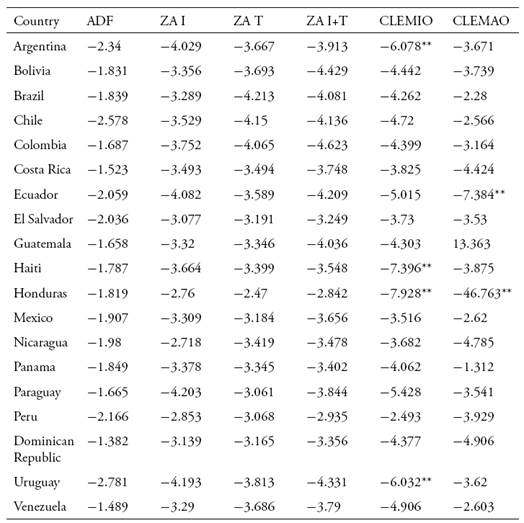External cycles and commodities in Latin America and the Caribbean: a cointegration analysis with breaks
DOI:
https://doi.org/10.17533/udea.le.n88a02Keywords:
external sector, structural breaks, cointegration, Latin AmericaAbstract
In this paper, we seek to characterize the relationship between the cyclical behavior of foreign accounts and commodity price indexes for Latin America and the Caribbean. Using several tests of stationarity that allow for the presence of breaks, we conclude that commodity prices are cointegrated with the current accounts in Latin American countries, suggesting that developmentalism plans did not obtain the desired productive diversification and that the region still relies heavily on commodities to determine its foreign position. Another important result supports the findings of Delbianco and Fioriti (2014, 2015) that the region had suffered two sudden stops in the last 60 years, both driven by shifts in commodity prices.
Downloads
References
Akpan, Uduak S.; Isihak, Salisu R. & Asongu, Simplice A. (2014). “Determinants of foreign direct investment in fast-growing economies: a study of BRICS and MINT”, AGDI Working Paper, WP/14/002. African Governance and Development Institute.
Albrieu, Ramiro (2012). “La Macroeconomía de los recursos naturales en América Latina”, En: Ramiro, Albrieu; López, Andrés & Rozenwurcel, Guillermo (Coords.) Los recursos naturales como palanca del desarrollo: ¿ficción o realidad? (pp. 105-153). Red Mercosur.
Bordo, Michael David (1980). “The effects of monetary change on relative commodity prices and the role of long-term contracts”, Journal of Political Economy, Vol. 88, No. 6, pp. 1088-1109.
Bouoiyour, Jamal & Selmi, Refk (2014). “Commodity price uncertainty and manufactured exports in Morocco and Tunisia: Some insights from a novel GARCH model”, Economics Bulletin, Vol. 34, No. 1, pp. 220-233.
Carrion-i-Silvestre, Josep L.; Kim, Dukpa & Perron, Pierre (2009). “GLS-based unit root tests with multiple structural breaks under both the null and the alternative hypotheses”, Econometric Theory, Vol. 25, No. 6, pp. 1754-1792.
CEPAL (2009). América Latina y el Caribe: Series históricas de estadísticas económicas, 1950-2008. Retrieved from: https://www.cepal.org/deype/cuaderno37/esp/index.htm
Clemente, Jesús; Montañés, Antonio & Reyes, Marcelo (1998). “Testing for a unit root in variables with a double change in the mean”, Economics Letters, Vol. 59, No. 2, pp. 175-182.
Chow, Gregory C. (1960). “Tests of equality between sets of coefficients in two linear regressions”, Econometrica, Vol. 28, No. 3, pp. 591-605.
Cody, Brian & Mills, Leonard (1991). “The role of commodity prices in formulating monetary policy”, The Review of Economics and Statistics, Vol. 73, No. 2, pp. 358-365.
Cuñado, Juncal; Gil-Alana, Luis Alberiko & Pérez de Gracia, Fernando (2003). “Empirical evidence on real convergence in some OECD countries”, Applied Economics Letters, Vol. 10, No. 3, pp. 173-176.
Cuñado, Juncal (2011). “Structural Breaks and Real Convergence in OPEC Countries”, Journal of Applied Economics, Vol. 14, No. 1, pp. 101–117.
Dabus, Carlos & Delbianco, Fernando (2014). “Non Convergence in Latin America, a structural break approach”, Working paper. Retrieved from: https://www.researchgate.net/publication/321058237_Non_Convergence_in_Latin_America_a_strcutural_break_approach.
Delbianco, Fernando & Fioriti, Andrés (2014). “The impact of commodities indexes in Argentina: A cointegration analysis with breaks”, The Empirical Economics Letters, Vol. 13, No. 11, pp. 1153-1158.
Delbianco, Fernando & Fioriti, Andrés (2015). “Dependence of Latin America external sector on commodity prices. A contemporaneity analysis using a descriptive approach”, Working paper. Retrieved from: https://www.researchgate.net/publication/321058228_Dependence_of_Latin_America_external_sector_on_commodity_prices_A_contemporaneity_analysis_using_a_descriptive_approach
Dickey, David & Fuller, Wayne (1979). “Distribution of the estimators for autoregressive time series with a unit root”, Journal of the American Statistical Association, Vol. 74, No. 366, pp. 427-431.
Duran Lima, José E. & Álvarez, Mariano (2011). “Manual de comercio exterior y política comercial. Nociones básicas, clasificaciones e indicadores de posición y dinamismo”, Colección Documentos de Proyectos, LC/w.430. Comisión Económica para América Latina y el Caribe, CEPAL.
Frenkel, Roberto & Rapetti, Martín (2011). “Fragilidad externa o desindustrialización: ¿Cuál es la principal amenaza para América Latina en la próxima década?”, Serie de la CEPAL, No. 116. División de Desarrollo Económico, CEPAL.
Gallagher, Kevin & Porzecanski, Roberto (2010). The Dragon in the Room: China and the Future of Latin American Industrialization. Palo Alto: Stanford University Press.
Garner, Alan C. (1989). “Commodity prices: Policy target or information variable? A note”, Journal of Money, Credit and Banking, Vol. 21, No. 4, pp. 508-514.
Herrera, Ana María & Pesavento, Elena (2009). “Oil Price Shocks, Systematic Monetary Policy and the ‘Great Moderation”, Macroeconomic Dynamics, Vol. 13, No. 1, pp. 107-137.
Kim, Dukpa & Perron, Pierre (2009). “Unit root tests allowing for a break in the trend function at an unknown time under both the null and alternative hypotheses”, Journal of Econometrics, Vol. 148, No. 1, pp. 1-13.
Liew, Venus Khim-Sen (2004). “Which lag length selection criteria should we employ?”, Economics Bulletin, Vol. 3, No. 33, pp. 1-9.
Lumsdaine, Robin & Papell, David (1997). “Multiple trend breaks and the unit-root hypothesis”, Review of Economics and Statistics, Vol. 79, No. 2, pp. 212-218.
Perron, Pierre & Vogelsang, Timothy (1992). “Nonstationarity and level shifts with an application to purchasing power parity”, Journal of Business & Economic Statistics, Vol. 10, No. 3, pp. 301-320.
Sachs, Jeffrey & Warner, Andrew (2001). “The Curse of Natural Resources”, European Economic Review, Vol. 45, No. 4-6, pp. 827-838.
Sen, Amit (2004). “Are US macroeconomic series difference stationary or trend-break stationary?”, Applied Economics, Vol. 36, No. 18, pp. 2025-2029.
Verheyen, Florian (2010). “Monetary Policy, Commodity Prices and Inflation: Empirical Evidence from the US”, Ruhr Economic Papers, No. 216. Ruhr-Universitat Bochum, Alemania.
Wei, Yanfeng (2013). “Commodity prices, manufactured goods prices and inflation: evidence from Japan”, Economics Bulletin, Vol. 33, No. 2, pp. 986-992.
Zivot, Eric & Andrews, Donald (1992). “Further Evidence on the Great Crash, the Oil-Price Shock and the Unit-Root Hypothesis”, Journal of Business and Economic Statistics, Vol. 10, No. 3, pp. 251-270.
Published
How to Cite
Issue
Section
License
Copyright (c) 2017 Fernando Delbianco, Andrés Fioriti

This work is licensed under a Creative Commons Attribution-NonCommercial-ShareAlike 4.0 International License.
This page, by Universidad de Antioquia, is licensed under a Creative Commons Attribution License.
Authors who publish with this journal agree to retain copyright and grant the journal right of first publication, with the article licensed under a Creative Commons Attribution-NonCommercial-ShareAlike License allowing others to share it as long as they acknowledge its authorship and original publication in this journal.
Authors can enter into separate, additional contractual arrangements for the non-exclusive distribution of the journal's published version of the work (e.g., post it to an institutional repository or publish it in a book), provided that these arrangements be not for profit and the journal be acknowledged as the original source of publication.
Authors are permitted and encouraged to post their papers online (e.g., in institutional repositories or on their websites), as it can lead to valuable exchanges as well as greater citation of the published work.


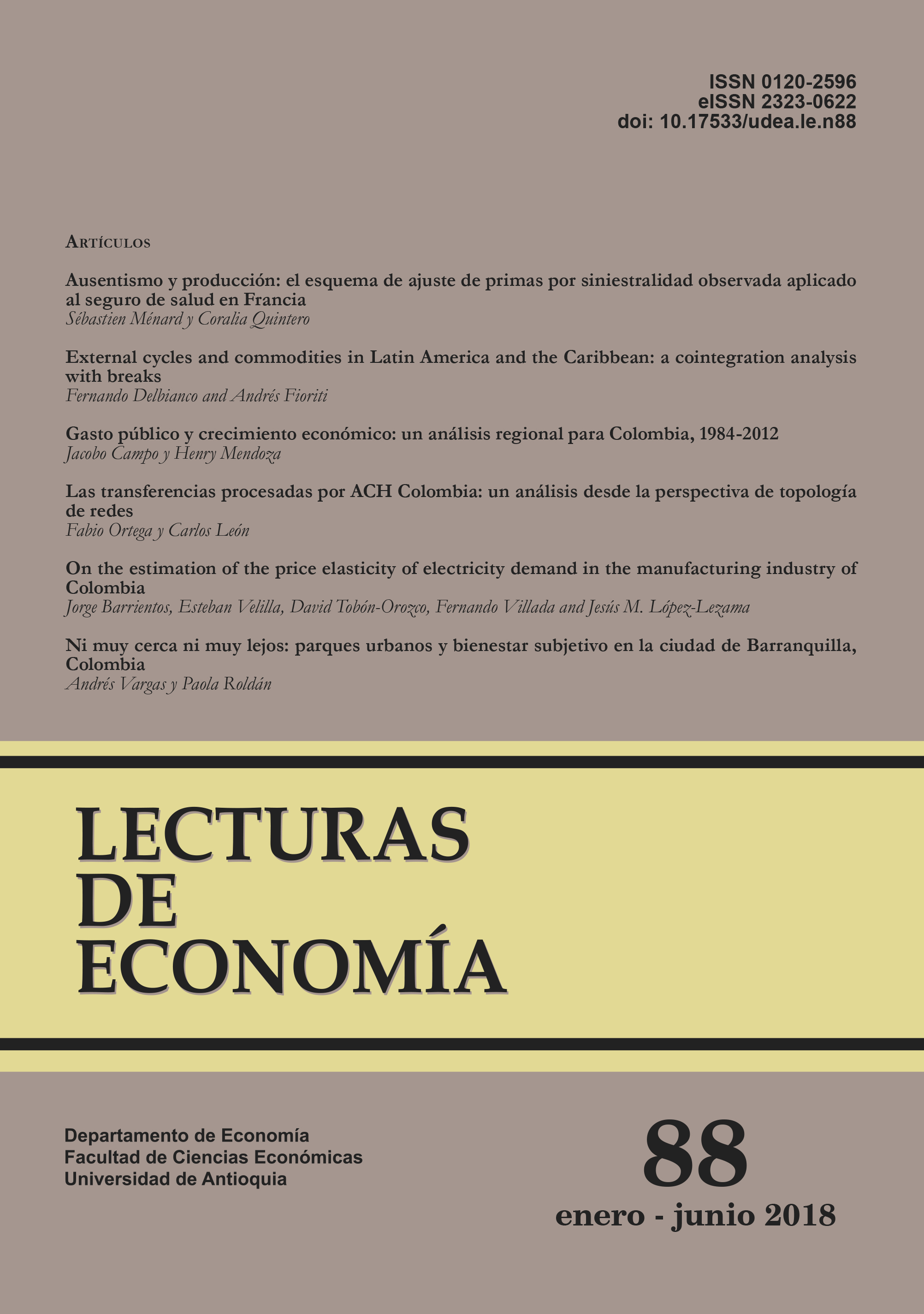







 are the lags and
µt
is the error term.
are the lags and
µt
is the error term. 





 is the difference between the growth rate of y and the growth rate of x, y denotes the price indexes (soybeans, agriculture, metals, energy and non- fuel). The lags are denoted by p, which are included to prevent autocorrelation issues.
is the difference between the growth rate of y and the growth rate of x, y denotes the price indexes (soybeans, agriculture, metals, energy and non- fuel). The lags are denoted by p, which are included to prevent autocorrelation issues. 
